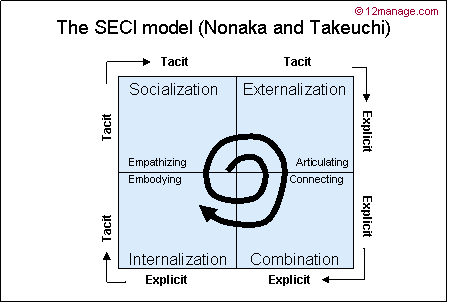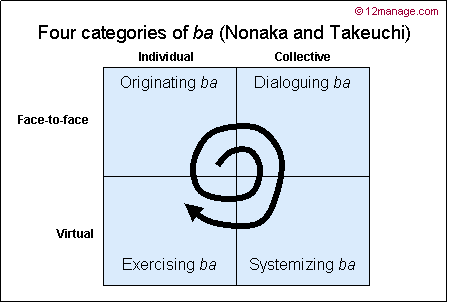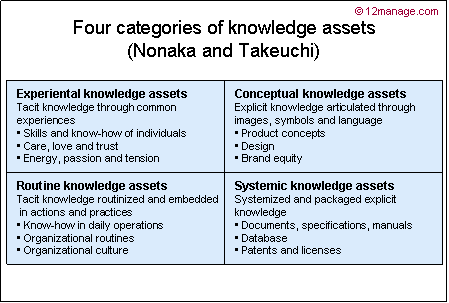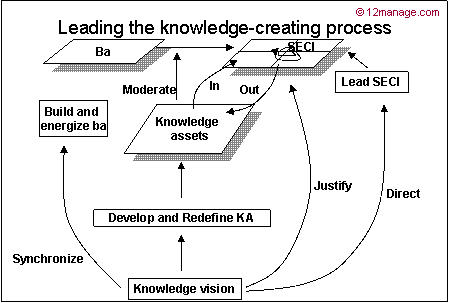Was ist das SECI Modell?

Ikujiro Nonaka und Hirotaka Takeuchi schlagen ein Modell des wissensschaffenden Prozesses vor, um die dynamische Natur der Wissenskreation zu verstehen, und solch einen Prozess effektiv zu handhaben: das SECI Modell. Es besteht aus 3 Elementen:
- SECI
- Ba
- Wissensvermögenswerte
Diese 3 Elemente wirken organisch und dynamisch aufeinander ein. Die Wissensvermögenswerte einer Organisation werden im „Ba“ mobilisiert und geteilt, während das stille Wissen, das von den Einzelpersonen gehalten wird, durch die Spirale des Wissens umgewandelt und verstärkt wird durch:
- Sozialisierung
- Externalisierung
- Kombination
- Internalisierung
Die drei Elemente sollten unter klarer Führung integriert werden, damit die Organisation Wissen ununterbrochen und dynamisch schaffen kann: es muss zu einer Disziplin für organisatorische Mitglieder werden.
SECI
Die Kreation des Wissens ist ein dynamischer Prozess von dynamischen Interaktionen zwischen stillem und explizitem Wissen. Die vier Modi der Wissensumwandlung wirken in der Spirale der Wissenskreation aufeinander ein. Die Spirale wird im Umfang größer, während sie sich durch organisatorische Niveaus nach oben bewegt, und kann neue Spiralen der Wissenskreation auslösen.

Sozialisierung. Teilen des stillen Wissens durch vertrauliche Kommunikation oder geteilte Erfahrung. Ein Beispiel ist eine Ausbildung.
Externalisierung. Entwickeln von Konzepten, die das kombinierte stille Wissen einbetten. Und die seine Kommunikation ermöglichen.
Kombination. Kombination der verschiedenen Elemente des expliziten Wissens: ein Beispiel ist das Bauen eines Prototypen.
Internalisierung. Eng verbunden mit "learning by doing", wird das explizite Wissen Teil der Wissensbasis der Einzelperson (z.B. mentale Modell) und wird zu einem Vermögenswert für die Organisation.
Ba
Dieses schwierige Konzept (es gibt keine genaue Übersetzung des Wortes) kann als geteilter Kontext definiert werden, in dem Wissen durch Interaktion geteilt, geschaffen und verwendet wird.
Das Diagramm veranschaulicht die verschiedenen Arten des Ba, jede einen Kontext für einen spezifischen Schritt im wissensschaffenden Prozess anbietend.
Beispiele der Kategorien, am Beispiel von Seven-Eleven (japanische Verbrauchergeschäfte):
- Entstehen des Ba: die Geschäftsfläche, sie ermöglicht Personen untereinander und mit Kunden zu interagieren.
- Mitteilen des Ba: das stille Wissen der lokalen Angestellten wird verwendet, um Verkaufprognosen im Dialog miteinander zu schaffen.
- Systematisieren des Ba: die Prognosen von Verkäufen werden gegen die Absatzerfolge geprüft und zu den lokalen Geschäften rückgekoppelt.
- Ausübung des Ba: das Benutzen dieser Informationen und das Vergleichen dieser mit der Wirklichkeit, verbessert die Fähigkeiten und Talente des Personals, um die Prognosen zu bilden.
Wissensvermögenswerte

Dieses sind unternehmensspezifische Ressourcen, die unentbehrlich sind, um Werte für das Unternehmen zu schaffen. Sie sind die Inputs, Outputs und moderierenden Faktoren des wissensschaffenden Prozesses.
Um Wissenskreation und Ausnutzung effektiv zu handhaben, muss eine Firma ihren Bestand an Wissensvermögenswerten „abbilden“. Das Katalogisieren ist jedoch nicht ausreichend: Wissensvermögenswerte sind dynamisch; neue Wissensvermögenswerte können durch vorhandene Wissensvermögenswerte geschaffen werden.
Die Rolle der Führung wird im Folgenden Diagramm veranschaulicht:

Ursprung des SECI Modell. Geschichte
Das Modell von Nonaka und Takeuchi basiert auf Polanyi's Unterscheidung zwischen stillem und explizitem Wissen (1983) und stellt ein Verständnis der Wissenskreation und des Managements aus einer japanischen Unternehmenskulturperspektive zur Verfügung.
Stärken des SECI Modell. Nutzen
- Würdigt die dynamische Natur des Wissens und der Wissenskreation.
- Stellt ein Rahmenwerk für das Management der relevanten Prozesse zur Verfügung.
Einschränkungen des SECI Modell. Nachteile
- Es basiert auf einer Studie japanischer Organisationen, die stark auf stillem Wissen beruhen: Angestellte arbeiten häufig ihr Leben lang für das gleiche Unternehmen.
- Die Linearität des Konzeptes: kann die Spirale Schritte überspringen? Kann sie linksherum gehen?
Buch: Ikujiro Nonaka, Hirotaka Takeuchi - The Knowledge-Creating Company
|
SECI Modell Fachgruppe.

Fachgruppe (20 Mitglieder)
|
|
|
Forumsdiskussionen über SECI Modell.

|
SECI for Integration Between ETOM and KM System
The SECI model has been implemented in many industries.
The Telecom industry has eTOM as business process framework with critical knowledge in each level of processes.
A specific effort is need to i...
 7 |

|
History of Knowledge Management
I found that other models and concepts came after SECI model. Referring to history,
- "Since 1975, the knowledge management (KM) related developments have been the emerging subject in organizations"...
 5  1 Kommentare |

|
Linking SECI Model to Innovation
I have some thoughts on how Knowledge Management and Innovation are linked... There are a number of models for implementing innovation. A simple model that I like involves 5 steps:
1. Idea Generation...
 4  2 Kommentare |

|
SECI Software Tools?
Hi Everybody. I am looking for a software solution to support a SECI implementation.
Does anybody has a software product in mind? One based on SECI model?
Best regards......
 4  2 Kommentare |
|
|
|
Kurse über SECI Modell.

Anfängerkurs
|

Fortgeschrittener Kurs
|

Kurs für Experten
|
|
|
|
Die am besten bewerteten Themen über SECI Modell. Hier finden Sie die wertvollsten Ideen und praktischen Vorschläge.
|
|
|
Erweiterte Einblicke zu SECI model (Englisch). Hier finden Sie professionelle Ratschläge von Experten.

Beratungstipps
|

Unterrichtstipps
|

Praktische Umsetzungstipps
|
|
|

|
Barriers that Hinder Effective Knowledge Sharing Effective Knowledge Sharing, Pitfalls to Avoid, Knowledge Management Implementation
According to Chris Collison, there are seven common barriers or syndromes that hinder effective knowledge sharing and se...
|

|
9 Major Definitions of Knowledge Management Knowledge Management
- KM is the "process of collecting, organizing, classifying and disseminating information throughout an organization, so...
|

|
How to Identify and Map Knowledge Knowledge Identification, Knowledge Capturing, Knowledge Storage
In his article “Knowledge Mapping: The Essentials for Success”, Wesley Vestal provides following six tips to identify an...
|

|
The N-Form Organization (Hedlund) Alternate KM Framework
Gunnar Hedlund of the Stockholm School of Economics introduced the notion of the N-Form corporation in 1994. He proposed...
|

|
Critical Activities to Build a Learning Organization Implementing Organizational Learning, Best Practices
Learning organizations are distinguished because they are undertaking certain activities to foster the internal learning...
|

|
Capturing Learned Lessons How to Capture Organizational Learning? Best Practices
Knowledge from bad and good experiences will lead you and your organization to better future performance. You can improv...
|

|
Knowledge Management Scope Knowledge Management, Level of Know-how
Research by Deishin Lee (HBS) and Eric Van den Steen (MIT) shows that recording mediocre know-how can actually be counte...
|

|
Three Pillars of Knowledge Management (WiiG) Alternate KM Framework
Karl Wiig is one of the pioneers in the field of Knowledge Management and was among the first to publish a series of tex...
|

|
Components of Learning Agility Organizational Agility, Organizational Learning, Knowledge Management
One of the critical factors for achieving organizational agility is learning agility, which refers to the ability and ea...
|

|
Positive Effects of Age Diversity on Company Productivity and (Tacit) Knowledge Sharing Tacit Knowledge Transfer, Workforce Productivity, Incentive Management
Backes-Gellner and Veen (2013) outlined the main advantages of having a diverse workforce within a company. The followin...
|

|
Knowledge Management Focal Point Knowledge Management Focus
Research by Deishin Lee (HBS) and Eric Van den Steen (MIT) shows that information about successes is typically more usef...
|
|
|
|
Verschiedene Informationsquellen zu SECI Modell. Hier finden Sie Powerpoints, Videos, Nachrichten usw., die Sie in Ihren eigenen Vorträgen und Workshops verwenden können.

|
Revisiting Knowledge Management Integrating Knower with the Knowledge Processes
Very good paper by Madhukar Shukla gives historic overview of KM, 3 dimensions of KM and future directions of KM....
|

|
How Businesses can Use Information Technology (IT) in Strategic Ways Strategic Management, Information Technology
This presentation looks at Information Technology from a strategic point of view. In other words, it discusses in what w...
|

|
People and Latent Knowledge in Organizational Learning Knowledge Creation, Explicit Knowledge, Tacit Knowledge
Knowledge management theory has struggled with the concept of knowledge creation. Since the seminal article of Nonaka in...
|

|
How to Improve Knowledge Sharing in Knowledge-intensive Organizations Knowledge Management, Knowledge Sharing Motivation, Knowledge Sharing Platform. Tacit Knowledge
This presentation elaborates on the concept of knowledge sharing, thereby focusin on a knowledge-intensive organization ...
|

|
Introduction to Knowledge Management: Foundation Principles and Building Concepts Knowledge Management, Knowledge Sharing, Learning Organization
1. What is Knowledge?
1. What is Knowledge Management? Definition
2. Knowledge Foundation Principles and Building Conc...
|

|
Knowledge Transfer and Knowledge Sharing Knowledge Management, Knowledge Sharing, Knowledge Transfer
Preentation that is an introduction into the concept of Knowledge Transfer, including its fundamentals, strategies, guid...
|

|
Overview of Existing Types of Knowledge Knowledge Management, Knowledge Types, Tacit, Implicit, Explicit, Declarative, Procedural Knowledge
This presentation provides an overview of the different types of knowledge that exist. The presentation includes the fol...
|

|
Knowledge Management Systems Architecture Knowledge Management, Knowledge Creation, Knowledge Systems, Knowledge Architecture
This presentation is about knowledge development and management, including the following sections:
1. Overview
2. Know...
|

|
How to Integrate Internal Organizational Knowledge with External Online Communities Knowledge Management, Knowledge Creation, Knowledge Sharing, Interaction, Knowledge in Organizations
Due to many online and web-based technological developments in today´s digital economy, sharing knowledge in online comm...
|

|
Leveraging Cognition for Competitive Advantage:A Knowledge-Based Strategy Process Knowledge-intensive firms
Article by Senthil K. Muthusamy and Ramaraj Palanisamy. One of the central bases for achieving competitive advantage is ...
|

|
Discovering Knowledge Management Forces Healthcare
This paper by Khalid Samara is an ongoing research in the area of knowledge management (KM) and evidence-based practice ...
|

|
Introduction and Summary of SECI Initial Understanding of SECI. Start of workshop/training
Knowledge Management
Is utilizing tacit (the unseen huge part of the iceberg), as well as explicit (the tip of the iceb...
|

|
Knowledge Creation: The SECI Model Knowledge Management, Knowledge Creation
Presentation about the SECI model of Nonaka and Takeuchi (1996), a model about knowledge creation. The model is based on...
|

|
Knowledge Sharing and Organizational Learning through Communities of Practices Knowledge Sharing, Organizational Learning, Communities of Practices, Special Interest Groups
Knowledge management in Communities of Practice (CoPs)
This presentation is about organizational learning and knowledge...
|

|
SECI Model Diagrams Knowledge Management
Download and edit these 12manage PowerPoint graphics for limited personal, educational and business use.
Republishing i...
|

|
Knowledge Transfer in the E-world Knowledge Management, Knowledge Transfer, Internet, Intranet, E-Business, CRM
This is a presentation about Knowledge Transfer (KT), specifically focused on KT in the e-world. The presentation consis...
|

|
3 Pillars of KM Knowledge Management
Three Pillars of Knowledge Management (Wiig)....
|

|
N-Form Organization Knowledge Management
The Dynamics of Knowledge Management in an N-Form Organization....
|
|
|
|
Nützliche Tools bezüglich SECI Modell.

Nachrichten
|

Videos
|

Präsentationen
|
| |

Bücher
|

Akademisch
|

Mehr
|
|
|
|
Vergleichen Sie mit dem SECI Modell: Bridging Epistemologies-Konzept | Organisationales Lernen | Organisationsgedächtnis | Aktionsbasiertes Lernen | Wissensmanagement (Collison u. Parcell)
Zurück zur Managementdisziplin: Wissen & immaterielle Werte | Führung
Mehr Managementmethoden, Modelle und Theorie
|
|
|
















